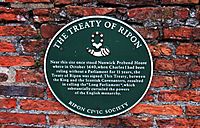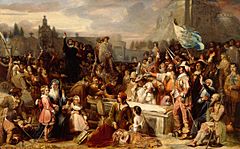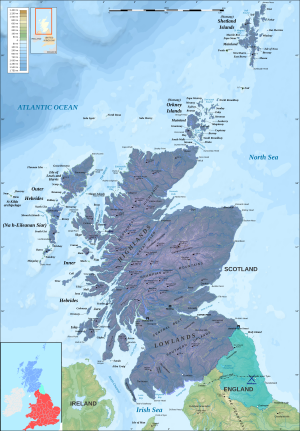Treaty of Ripon facts for kids

Plaque commemorating the signing of the treaty
|
|
| Context | Bishops' Wars |
|---|---|
| Drafted | 16 October 1640 |
| Signed | 28 October 1640 |
| Location | Ripon |
| Negotiators | |
| Original signatories |
Charles I |
| Parties | |
The Treaty of Ripon was an important agreement signed on 28 October 1640. It was made between King Charles I and the Scottish group known as the Covenanters. This treaty happened right after the Second Bishops' War. It was a big moment that led to more problems for King Charles.
The Bishops' Wars were fights between the Covenanters and King Charles. The Covenanters wanted to stop Charles from changing the Church of Scotland. They didn't want the king to have too much power over their church. They also didn't like the idea of bishops being in charge. The Scots won a major battle at Newburn in August 1640. This victory gave them control over parts of England, including Northumberland, County Durham, and Newcastle upon Tyne.
King Charles tried to avoid calling Parliament. Instead, he called a special meeting of nobles called the Great Council of Peers. This council hadn't met for 100 years! The nobles agreed to talk with the Scots. But they said Parliament had to approve any final deal. Until then, the Scots could stay in Northumberland and Durham. They also had to be paid £850 every day. Charles had to accept these tough terms.
This forced King Charles to call a new Parliament, known as the Long Parliament. He couldn't get rid of this Parliament easily. This situation eventually led to the First English Civil War.
Contents
Why the Treaty Was Needed
The National Covenant
After the Protestant Reformation, Scotland had its own church, called the 'kirk'. It was set up differently from the Church of England. The Scottish church was run by 'presbyters', who were elected by ministers and elders. The English church was run by 'bishops', often chosen by the king.
In the 1600s, being 'Presbyterian' or 'Episcopalian' wasn't just about church rules. It was also about who had power. It was about whether the king or the church leaders had more control.
When King James VI of Scotland also became King of England in 1603, he wanted to unite the churches. His son, King Charles I, continued this plan. But the two churches had different beliefs. Many English Puritans also didn't like Charles's changes to the Church of England.
In 1636, Charles brought in new church rules for Scotland. These rules said that anyone who didn't agree with the king's power in church matters would be kicked out. Charles didn't ask the Scottish church or Parliament first. This made people in Scotland very angry.
Then, in 1637, a new prayer book was introduced. This caused riots. In February 1638, many Scots signed the National Covenant. This was a promise to resist the king's new church rules. It showed how unhappy people were with a king who wasn't often in Scotland. Many important Scottish nobles supported the Covenant.
King Charles said he would discuss the new rules. But he didn't plan to change his mind. When the Scottish church leaders met in Glasgow in December, they rejected his changes. They also said bishops couldn't be part of the church. They insisted on meeting every year, not just when the king allowed it. One of Charles's advisors told him that war was now unavoidable. The Scottish Parliament started getting soldiers ready. They also looked for help from other countries and from English Puritans. King Charles saw this as a rebellion. He gathered an army to march into Scotland.
The Bishops' Wars
In March 1639, the Scottish Covenanter forces took control of Edinburgh. This started the First Bishops' War. This war ended quickly in June with the Treaty of Berwick, without a big battle.
After this, Charles called the Short Parliament in April 1640. He needed money for another fight against Scotland. But Parliament refused to give him money. They wanted him to fix other problems first. So, Charles closed Parliament after only three weeks. He then tried to get money from the Parliament of Ireland. He planned another attack on Scotland. This plan included an army from Ireland and a naval blockade.
The Covenanters' success in Scotland encouraged Charles's opponents in England. These opponents, led by John Pym, secretly talked with the Scots. They wanted to limit the king's power in England. Many people were unhappy with Charles's rule, which had lasted over ten years without Parliament.
With this encouragement, and warnings about the king's plans, the Covenanters attacked England. They went around the heavily guarded city of Berwick. This started the Second Bishops’ War. The Scottish forces defeated the king's army at the Battle of Newburn. They then took Newcastle on 30 August 1640. After this, the Scots continued south. They occupied Durham and set up a defense line on the River Tees.
Negotiations for Peace
With Newcastle and much of Northumberland and Durham under Scottish control, King Charles had a big problem. He called the Great Council of Peers to meet in York. This was the first time this group had met in 100 years! The Council decided not to act like Parliament. But they did agree to talk with the Covenanters about a treaty.
Meanwhile, the Scottish army was running out of supplies. They started collecting money from nearby towns and churches. They also took money from Newcastle to pay their soldiers. This lack of supplies actually gave the Covenanters an advantage in talks. There were already reports of soldiers taking things from people. The English lords didn't want the Scottish army to become a wild mob. But Charles couldn't afford to pay the Scots without Parliament's help. This made it clear that a deal involving both the king and Parliament was necessary. The Covenanters, working with the king's English opponents, refused to leave until Charles called the English Parliament.
What the Treaty Said
The Treaty of Ripon had several key points:
- The Scottish army would continue to occupy Northumberland and Durham.
- England would pay the Scots £850 every day, starting from 16 October.
- Both sides agreed to stop fighting for a while.
- This situation would continue until a full, lasting agreement was made.
- The Scottish Government would also be paid back for their war costs.
These terms were very embarrassing for King Charles. But he was desperate to stop the Covenanters from taking York. He had little support from his own nobles. So, he had no choice but to agree.
The final terms were decided on 16 October. King Charles accepted them on 28 October. Talks for a permanent peace continued until August 1641. That's when the Treaty of London was signed.
What Happened Next
King Charles had to call what became known as the Long Parliament. It met on 3 November 1640. This ended his eleven years of "Personal Rule," where he ruled without Parliament. The Scots made it clear they would only go home once they were paid. They would only agree to terms with Parliament. This meant Charles now faced a Parliament he couldn't just get rid of. The Covenanters used their army's presence in England to help the king's English opponents.
Over the next few months, Parliament made sure the king couldn't dissolve it without its own permission. They also arrested Archbishop Laud and executed the Earl of Strafford. Only then did Parliament agree to the Treaty of London on 10 August 1641. This treaty agreed to pay the Scots £300,000 for the war. The Covenanters' army then went back to Scotland, where most of the soldiers were sent home.
Disagreements between King Charles and Parliament kept getting worse. This led to Charles trying to arrest five Members of Parliament in January 1642. Charles left London and started gathering support for himself. The First English Civil War began on 22 August 1642.
See also



